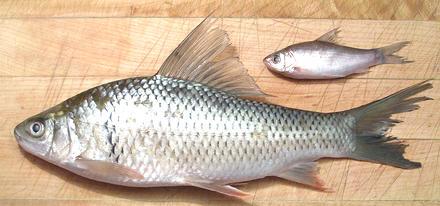 After taking my photo, I had a tray of tiny carp. What to do with them?. I
certainly wasn't about to make stinky prahoc, especially with so few fish.
After taking my photo, I had a tray of tiny carp. What to do with them?. I
certainly wasn't about to make stinky prahoc, especially with so few fish.
 [Cirrhinus molitorella (Asia)
- similar but not commercial, Leuciscus leuciscus (Europe)]
[Cirrhinus molitorella (Asia)
- similar but not commercial, Leuciscus leuciscus (Europe)]
A common fish in fast moving fresh (or sometimes brackish) waters with a worldwide distribution in temperate climates. Dace is commonly catagorized as a "course" fish and not used much for food in the U.S. or Europe, but is quite popular in Asia for making fish balls.
The photo specimen was 11-3/4 inches long and weighed 10-1/4 ounces, fairly typical. Some markets also have trays of small dace. The photo specimen was 4-1/2 inches long and weighed 5/8 ounce, but the tray contained fish from 1/4 ounce to 1-3/8 ounces. In Cambodia small dace are used to make prahoc, a pungent fermented fish condiment. See below for my method of using them.
More on Carp Family.
Dace yields white flesh of good flavor, but it's quite a chore to eat since the flesh, as with all carp, is shot full of annoying spines. Because this is such a small fish compared to regular carp, dealing with all those spines is a lot of trouble for not too much reward.
So why do Asian fish markets have bins of frozen Dace, a nearly inedible fish? Well, because, as with the inedible Featherback, it's considered a prize fish for making fish balls.
 After taking my photo, I had a tray of tiny carp. What to do with them?. I
certainly wasn't about to make stinky prahoc, especially with so few fish.
After taking my photo, I had a tray of tiny carp. What to do with them?. I
certainly wasn't about to make stinky prahoc, especially with so few fish.
I cut off the heads and gutted them, rinsing them out well. I pinched
off the exposed part of backbone (about 1/2 inch), which took most of the
exposed ribs with it. I did not scale them - I just deep fried them in
some olive pomace oil to a nice medium brown, then drained on paper towels.
I made up a dipping sauce from rice vinegar and a little fish sauce. This
worked very well and I wouldn't hesitate to serve them this way as an
appetizer.